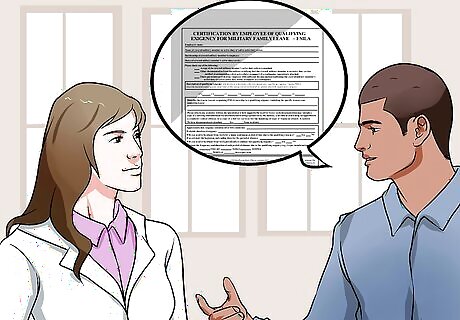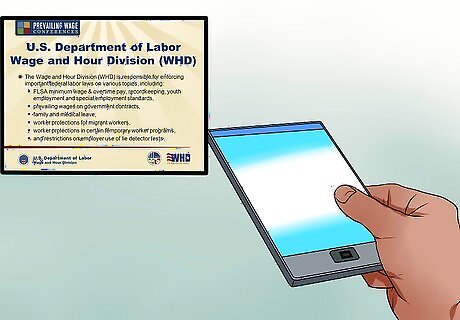
views
X
Trustworthy Source
US Department of Labor
Federal department responsible for promoting the wellbeing of workers
Go to source
Requesting Qualifying Exigency Leave

Identify a qualifying reason. You can request FMLA leave for up to 12 weeks if your spouse, parent, or child will be deployed on active duty to a foreign country. Your leave request must be for at least one of the seven allowed reasons, and the total leave for which you're eligible may depend on the reason. You may take up to 12 weeks of leave for military events and related activities including post-deployment activities, child care and school activities, counseling, or financial and legal arrangements. If your spouse, parent, or child is called to duty with notice of seven days or less, you may take up to seven calendar days of leave to handle any issues related to that short-notice deployment. If your spouse, parent, or child is on short-term, temporary leave from active duty for rest and recuperation, you may take up to five days of FMLA leave to be with him or her.

Provide as much notice as possible. General FMLA guidelines allow employers to require you to give at least 30 days' notice if you plan to take time off using FMLA leave. However, in some circumstances you may not know about your need to take leave this far in advance, especially if your family member is deployed on short notice. Keep in mind that the regular FMLA rules apply to your request for military family leave. You don't have to request all of your leave be taken at the same time. You can ask for intermittent leave within the same leave request, or request a reduced schedule rather than time completely off work. The amount of leave to which you are entitled is a maximum during a single 12-month period.The 12 weeks you're allowed to request for military family leave is not in addition to regular FMLA leave. For example, if you have already used six weeks of FMLA leave for your own serious health condition, you only have six weeks of leave available for qualifying exigency leave.

Meet your employer's certification requirements. If you are requesting leave for a qualifying exigency, your employer may require documentation of your relationship to the service member and details regarding his or her deployment. After you've notified your employer of your request for leave under the FMLA, you have 15 calendar days to supply any information required by your employer to certify your request. If you don't provide sufficient information within 15 days, your employer may lawfully deny your request. Your employer may request a copy of the military member's active duty orders or other military documentation indicating the military member's deployment. You also may be required to provide additional documentation of the particular reason you're requesting leave, such as copies of bills for legal or financial arrangements, announcements of meetings or events, or appointment confirmation letters. If you are meeting a third party, your employer may ask for contact information to confirm the reasons for the leave you've requested.

Find out your employer's decision. Within five days of your request, or after you've provided the required information to certify your request, your employer must inform you of whether you are eligible to take leave under FMLA, and whether your request for leave has been approved. If your employer determines you aren't eligible for FMLA leave, the notice must specify the reasons you are ineligible. If your request is approved, the notice will include the dates for which your leave has been approved. FMLA leave is unpaid, but portions of your leave may include paid leave if your employer offers paid leave and requires you to exhaust any paid leave you've accrued before FMLA kicks in. Keep in mind that while you're on leave you're still responsible for covering your health insurance premiums, if you have health insurance through your employer that is deducted from your paycheck. Your leave notice will include instructions on how to calculate the amount you owe and how and when to pay your monthly premiums.

Consider filing a complaint with the U.S. Department of Labor (DOL). If you believe your employer has wrongfully denied your right to FMLA leave, you can file an administrative complaint with the Wages and Hours Division of the DOL. You can call the Wages and Hours Division at 1-866-487-9243 between 8:00 a.m. and 8:00 p.m. Eastern time, Monday through Friday. The representative can answer any questions you have regarding FMLA. If you want to file a complaint, you can do so over the phone or in person at your nearest DOL office. You must have information ready about yourself, your employer, your FMLA request, and the stated reasons for denial of your request.
Requesting Military Caregiver Leave

Gather information related to your request. You can request up to 26 weeks of unpaid leave to care for a seriously ill or injured family member who is a current service member or veteran. The service member's injury or illness generally must have been incurred in the line of duty, or while the person was on active duty. The definition of "family member" is expanded for military caregivers relative to the usual FMLA leave. While the FMLA generally only covers leave to care for your spouse, parents, or children, you also can request military leave to care for your "next of kin," which includes other blood relatives such as siblings, grandparents, aunts, uncles, and first cousins. However, if you are requesting military caregiver leave under a next-of-kin designation, you must be able to prove that you are the only relative of the service member who qualifies for FMLA leave. Your leave request must be to care for your family member while he or she is treated or recovers from a serious injury or illness incurred in the line of duty. The injury or illness also can be pre-existing if service in the line of duty exacerbated the condition. An injury or illness generally is considered serious if it renders the service member medically unfit to perform the duties of his or her military office, rank, grade, or rating. If your family member is a veteran, he or she must have been discharged within five years of your first leave request.

Determine how much time you need. While the FMLA allows you to take as many as 26 weeks, this leave is unpaid. Before you max out the leave available, evaluate exactly how much time you need to care for your family member. The FMLA allows 26 weeks within a single 12-month period. This 26 weeks is not in addition to any other leave, so if you've already taken FMLA leave you must consider that amount in your calculation of the amount of leave you have available. As with other types of leave, you can request time off intermittently, or in the form of a reduced schedule. For example, if your family member has physical therapy for three hours every morning, you may want to work until lunch time and then take off in the afternoons.

Notify your employer. Under the FMLA, you're generally required to notify your employer at least 30 days before you need to take your leave. If you are unable to provide that much notice, you should be prepared to tell your employer why. When you make your leave request, you should state specifically that you are requesting military caregiver leave under the FMLA. Outline the reasons for your request, and let your employer know that you are willing to supply any evidence needed to support your request. Within five days of receipt of your request, your employer must notify you whether your leave is covered by the FMLA and provide a list of any documents required to certify your request.

Provide the required evidence supporting your request. Your employer may request documentation proving your relationship to a covered service member and the reason for your leave, including evidence of the service member's serious injury or illness. If your employer requests supporting documentation, you have 15 calendar days to provide sufficient information or your employer may deny your request for leave. Your employer may request contact information for the service member's authorized healthcare provider, the type of medical practice, and whether the practice is affiliated with the military. You also may have to provide facts about the service member's condition, his or her diagnosis, the likely duration of the condition, and estimates of the time period and frequency of necessary treatments. Your employer also may request proof of the service member's branch, rank, and unit assignment, as well as his or her date and type of separation in the case of veterans.

Receive your employer's decision. Once your employer receives your request and any required documents to certify the reasons for your request, you will be notified within five days of whether your employer has granted or denied your request for leave. Keep in mind that you are not protected by FMLA if you take time off before your employer has approved your specific request. If you have to leave early or miss work before then, you must follow your employer's normal policies for calling out. If your employer approves your request either in whole or in part, the notice will include the dates or times for which you've been approved to take FMLA leave. If you have health insurance through your employer, the notice also may contain information on how to continue to pay your health insurance premium while you are on leave. Your employer may require you to substitute your requested FMLA leave with any accrued paid leave. These amounts will be included in your notice.

Contest any wrongful denial with the U.S. Department of Labor (DOL). If your employer refuses to grant you leave under the FMLA and you believe your employer's reasons are false or inadequate, you can file an administrative complaint with the DOL's Wages and Hours Division. If you have questions or want to file a complaint, you can call the DOL's helpline from 8:00 a.m. to 8:00 p.m. Eastern time Monday through Friday. The toll-free number is 1-866-487-9243. You also can file a complaint in person by visiting the DOL office nearest you. If you plan to file a complaint, make sure you have information ready, including the name and contact information of your employer, details about your leave request, and the stated reasons your employer denied your request.




















Comments
0 comment